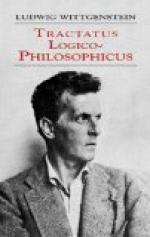5.43 Even at first sight it seems scarcely credible that there should follow from one fact p infinitely many others , namely PPp, PPPPp, etc. And it is no less remarkable that the infinite number of propositions of logic (mathematics) follow from half a dozen ‘primitive propositions’. But in fact all the propositions of logic say the same thing, to wit nothing.
5.44 Truth-functions are not material functions. For example, an affirmation can be produced by double negation: in such a case does it follow that in some sense negation is contained in affirmation? Does ‘PPp’ negate Pp, or does it affirm p—or both? The proposition ‘PPp’ is not about negation, as if negation were an object: on the other hand, the possibility of negation is already written into affirmation. And if there were an object called ‘P’, it would follow that ‘PPp’ said something different from what ‘p’ said, just because the one proposition would then be about P and the other would not.
5.441 This vanishing of the apparent logical constants also occurs in the case of ‘P(dx) . Pfx’, which says the same as ‘(x) . fx’, and in the case of ‘(dx) . fx . x = a’, which says the same as ‘fa’.
5.442 If we are given a proposition, then with it we are also given the results of all truth-operations that have it as their base.
5.45 If there are primitive logical signs, then any logic that fails to show clearly how they are placed relatively to one another and to justify their existence will be incorrect. The construction of logic out of its primitive signs must be made clear.
5.451 If logic has primitive ideas, they must be independent of one another. If a primitive idea has been introduced, it must have been introduced in all the combinations in which it ever occurs. It cannot, therefore, be introduced first for one combination and later reintroduced for another. For example, once negation has been introduced, we must understand it both in propositions of the form ‘Pp’ and in propositions like ‘P(p C q)’, ‘(dx) . Pfx’, etc. We must not introduce it first for the one class of cases and then for the other, since it would then be left in doubt whether its meaning were the same in both cases, and no reason would have been given for combining the signs in the same way in both cases. (In short, Frege’s remarks about introducing signs by means of definitions (in The Fundamental Laws of Arithmetic ) also apply, mutatis mutandis, to the introduction of primitive signs.)
5.452 The introduction of any new device into the symbolism of logic is necessarily a momentous event. In logic a new device should not be introduced in brackets or in a footnote with what one might call a completely innocent air. (Thus in Russell and Whitehead’s Principia Mathematica there occur definitions and primitive propositions expressed in words. Why this sudden appearance of words? It would require a justification, but none is given, or could be given, since the procedure is in fact illicit.) But if the introduction of a new device has proved necessary at a certain point, we must immediately ask ourselves, ’At what points is the employment of this device now unavoidable ?’ and its place in logic must be made clear.




